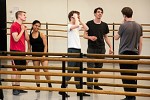Title
Dancers need a floor to dance on, light to dance under, sound to dance to, clothes to dance in, not to mention a dance to dance. After two years focused on the dancing, the time has come for the third-year dancers to learn how to coordinate all of the other ones. Our Stagecraft course, which meets every Monday morning from 9:00 to 10:15, covers the technical elements of production, from lighting, sound, and costume design to contract negotiation and company management. Its culmination will be stage-managing the Senior Dance Production—which opens on May 3 in the Willson Theater—along with dancing in it.
Third-year dancers (from left) Garth Johnson, Lea Ved, Jason Collins, and Christopher Kaiser talk about their performance with fourth-year choreographer Nathan Makolandra (back to the camera). The other senior choreographers for the May 3-6 Senior Production are Spencer Dickhaus, Melissa Fernandez, Ryan Redmond, Rachelle Scott, and Zack Winokur.
(Photo by The Juilliard Journal)Body
Stagecraft has given us an eye-opening view of the real-world physics that support the ephemeral world of art. We’re coming to realize the full scope of mathematics and machinery, manual labor and technological expertise that must bustle in constant activity backstage in order for dancers to meaningfully communicate minutes of abstract movement onstage. Here are a few of my journal entries from the early weeks of preparation for Senior Pro.
Sunday, March 25
In Stagecraft tomorrow morning, we’ll be putting a semester’s worth of new perspective to use in a discussion of lighting design plans for the show in May. Our teacher, Susan Hamburger, who’s a professional lighting designer, assigned us in groups of three or four to each of the six seniors’ pieces weeks ago, and now we have to present our ideas to the rest of the class. My group has been working on Nathan Makolandra’s piece, and he wants to create an atmosphere reminiscent of the digitized phosphorescence in the movie Tron: Legacy. We’re requesting black lights to shine from two corners and fluorescent strips (like the ones that will be on the dancers’ costumes) to line the walls—and we’re even contemplating the effect of a fog machine in our quest for the right glow of neon against black.
Monday, March 26
After morning classes today, I rode the elevator to D Level for a costume fitting. (“D” for “dress,” they say!) The red camisole and green khaki pants that I’ll be wearing for the spring repertory concert—the first dress rehearsal is tonight—has been approved for days, but for half of an hour, Melissa Fernandez’s costume designer pinned me into a mock-up of the purple racer-back dress that I’ll be wearing for her Senior Pro. We haven’t rehearsed Melissa’s piece since the end of January, when we tucked two weeks of progress into our back pockets before diving into preparations for Juilliard Dances Repertory, but apparently Melissa hasn’t stopped thinking about it since. She’s also dancing tonight, and I can’t imagine how she—and the other five choreographers—have space in their brains to prepare two shows at once.
Tuesday, April 3
Now that our rep concert is over, and those of us who performed in it have had a day off from dance classes to recover and reboot, we began to rehearse for Senior Pro again this evening. We started by watching a recording of the final showing we had of Melissa’s material in January, and thanks to muscle memory, most of the movement came back in a matter of moments. Melissa hopes to reconstruct the six or so minutes she made back then and add about six minutes of new material for her final product. Despite not loving watching myself dance on screen and despite returning to phrases in a different state of body and mind than I was in when I learned them, it’s comforting remembering the intricate flow of Melissa’s choreography. She’s drawing inspiration from the elements and from the interchanging partnering dynamics of the five dancers. “Senior Pro” may be our nickname for Senior Dance Production, but the process is revealing that the seniors are truly professional already.
Thursday, April 5
I’m looking forward to watching Nathan’s rehearsal tomorrow and to meeting with him afterward to finalize our requirements for the light plot—the arrangement of lights that we’ll hang in the Willson in order to accommodate the designs of every piece—which is due Monday. We heard word from Susan that we will have access to black lights and a fog machine, and she has been in full support of Nathan’s high-tech concept since our presentation last week. His newest image is of the stage space as a massive speaker and the dancers as the visual expressions of sound, so we have a lot to work with as we consider color palettes and cues. Starting in a couple of weeks, we’ll spend long hours on the gantry (the bridge that crosses the Willson at ceiling height) with gloves and wrenches affixing each Source Four Par and Source Four Leko light to the poles that crisscross overhead. Whenever we’re not actually onstage dancing come show time, we third years will be rotating through positions on the tech crew, operating the light and sound boards, and stage managing, too.





